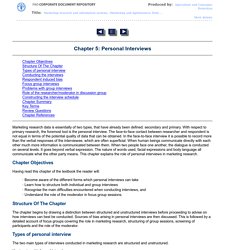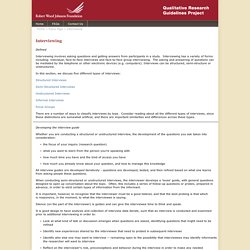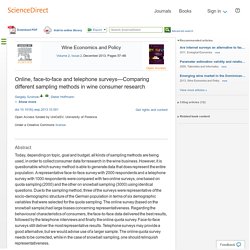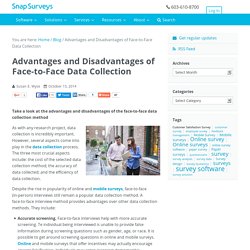

Interviewing. Advantages and Disadvantages of Four Interview Techniques in Qualitative Research. Volume 7, No. 4, Art. 11 – September 2006.

Telephone%20and%20Face to Face%20Interviews. Chapter 5: Personal Interviews. Chapter Objectives Structure Of The Chapter Types of personal interview Conducting the interviews Respondent induced bias Focus group interviews Problems with group interviews Role of the researcher/moderator in discussion group Constructing the interview schedule Chapter Summary Key Terms Review Questions Chapter References Marketing research data is essentially of two types, that have already been defined: secondary and primary.

With respect to primary research, the foremost tool is the personal interview. Qualitative Research Interviews. RWJF - Qualitative Research Guidelines Project. Defined Interviewing involves asking questions and getting answers from participants in a study.

Interviewing has a variety of forms including: individual, face-to-face interviews and face-to-face group interviewing. The asking and answering of questions can be mediated by the telephone or other electronic devices (e.g. computers). Interviews can be structured, semi-structure or unstructured. Primary Research Methods: Interviewing Techniques and Tips. View Worksheet Interviewing is a valuable primary research method, and choosing from the different interviewing techniques is the first step in the process of undertaking this type of research.

Interviews allow you to learn more detailed information. Whether you are interviewing one expert or gathering information from a small group of individuals, you must decide how to conduct the interview. The five most common interview techniques include the following interview types: Face-to-face interviewsWebcam interviewsTelephone interviewsEmail interviewsInstant message/chat interviews With each interviewing technique, there are advantages and disadvantages, so choosing the right one for your primary research method is done by considering the value of each type, time or location constraints and the personal preferences of you and the people you interview.
Interviewing techniques There are five main interviewing techniques you can use as a primary research method. Is There a Bias Against Telephone Interviews In Qualitative Research? Doyle Face to Face Surveys. Online, face-to-face and telephone surveys—Comparing different sampling methods in wine consumer research. <div class="msgBox" style="margin-top:10px;"><span class="errMsg"><div>JavaScript is disabled on your browser.

Please enable JavaScript to use all the features on this page. This page uses JavaScript to progressively load the article content as a user scrolls. Click the View full text link to bypass dynamically loaded article content. <a rel="nofollow" href=" full text</a></div></span></div><br /> Geisenheim University, Department of Business Administration and Market Research, Von-Lade-Str. 1, 65366 Geisenheim, Germany Available online 23 October 2013 doi:10.1016/j.wep.2013.10.001 Get rights and content Abstract Today, depending on topic, goal and budget, all kinds of sampling methods are being used, in order to collect consumer data for research in the wine business. Keywords. Request Rejected. The qualitative research interview - DiCicco-Bloom - 2006 - Medical Education.
08 Face to face Interview Kerstin Becker. Face-to-Face Interviews - Advantages and Disadvantages. Advantages and Disadvantages of Face-to-Face Data Collection. Take a look at the advantages and disadvantages of the face-to-face data collection method As with any research project, data collection is incredibly important.

However, several aspects come into play in the data collection process. The three most crucial aspects include: the cost of the selected data collection method; the accuracy of data collected; and the efficiency of data collection. Nes003217. A Practical Guide to the E-Mail Interview. EmeraldInsight. "Qualitative Interview Design: A Practical Guide for Novice Investigato" by Daniel W. Turner III. Abstract Qualitative research design can be complicated depending upon the level of experience a researcher may have with a particular type of methodology.

As researchers, many aspire to grow and expand their knowledge and experiences with qualitative design in order to better utilize diversified research paradigms for future investigations. One of the more popular areas of interest in qualitative research design is that of the interview protocol. Interviews provide in-depth information pertaining to participants' experiences and viewpoints of a particular topic. Often times, interviews are coupled with other forms of data collection in order to provide the researcher with a well-rounded collection of information for analyses. Keywords Informal Conversational Interview, General Interview Guide, and Open-Ended Interviews Publication Date Recommended APA Citation Turner, D. 10,411 Downloads Since November 19, 2014 Submission Location Use two fingers to move the map.